All posts by Andrea Grant
About Andrea Grant
Andrea Grant is a Children's Services Specialist. View all posts by Andrea Grant →

Bibliobites in December: The Pursuit of Happiness
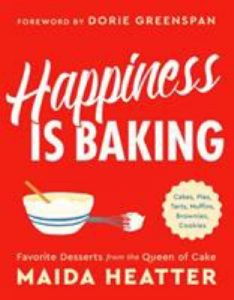 Prolific author and baking guru Maida* Heatter is known as the “Queen of Cake.” No one did more over the last quarter of the 20th century to up our dessert game, for once we’d tried her classic buttery and chocolatey delights, there was no going back. A self-trained baker with a no-nonsense, perfectionist approach, her precise yet luscious recipes inspired many to give baking the time and care it deserved. December’s Bibliobites title, Happiness Is Baking, was Ms. Heatter’s final book before she died in June 2019 at the age of 102. In her introduction, she says that with all the baked goods she creates, “…we eat an awful lot of them.” Perhaps noshing on cookies and cake confers longevity? Or is it, as the title implies, that it’s the baking and sharing of treats that keeps one happy and healthier? Our group is never shy about rising to any such challenge, and even if you don’t bake much, you’d probably be pulling out the butter and sugar at some point in December! Did we enjoy the ride? Read on to find out.
Prolific author and baking guru Maida* Heatter is known as the “Queen of Cake.” No one did more over the last quarter of the 20th century to up our dessert game, for once we’d tried her classic buttery and chocolatey delights, there was no going back. A self-trained baker with a no-nonsense, perfectionist approach, her precise yet luscious recipes inspired many to give baking the time and care it deserved. December’s Bibliobites title, Happiness Is Baking, was Ms. Heatter’s final book before she died in June 2019 at the age of 102. In her introduction, she says that with all the baked goods she creates, “…we eat an awful lot of them.” Perhaps noshing on cookies and cake confers longevity? Or is it, as the title implies, that it’s the baking and sharing of treats that keeps one happy and healthier? Our group is never shy about rising to any such challenge, and even if you don’t bake much, you’d probably be pulling out the butter and sugar at some point in December! Did we enjoy the ride? Read on to find out.
This book is a somewhat smaller format than many are nowadays, so an oft-repeated complaint was that the book would not stay open on its own. The text is quite readable, and the layout is clear. Chatty headnotes abound, but most weren’t long enough to try one’s patience. The illustrations are just that– drawings (full-color) rather than photographs. The drawings are lovely– homey and friendly, but most of us still wished that there were photos instead. Some in the group commented that they’d seen some of these recipes in another of her books; this title is basically a compilation of “greatest hits.”
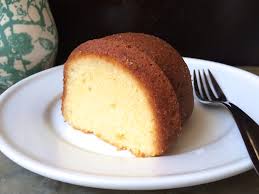 Once we’d turned on our ovens, there were ups and downs. Sour cream black-fudge loaf cake had a fantastic texture and big chocolate flavor, “loved it!” Queen mother’s cake , also chocolate, was another winner, a flourless cake that wasn’t too dense and was absolutely delicious. Two of us tried the east 62nd street lemon cake ; one person’s verdict was “just OK,” but for another it was “really good with a nice, fine texture.” California carrot cake sounded positively tantalizing with honey, raisins, pineapple, and walnuts; but the batter was so thin that all the fruit and nuts sank to the bottom, where they burned. Even when this cake tested done, the interior was unpleasantly wet and heavy. One person had a similar flop with chocolate applesauce cake, but two others thought it was marvelous, with a flavor that harmoniously united chocolate cake and spice cake.
Once we’d turned on our ovens, there were ups and downs. Sour cream black-fudge loaf cake had a fantastic texture and big chocolate flavor, “loved it!” Queen mother’s cake , also chocolate, was another winner, a flourless cake that wasn’t too dense and was absolutely delicious. Two of us tried the east 62nd street lemon cake ; one person’s verdict was “just OK,” but for another it was “really good with a nice, fine texture.” California carrot cake sounded positively tantalizing with honey, raisins, pineapple, and walnuts; but the batter was so thin that all the fruit and nuts sank to the bottom, where they burned. Even when this cake tested done, the interior was unpleasantly wet and heavy. One person had a similar flop with chocolate applesauce cake, but two others thought it was marvelous, with a flavor that harmoniously united chocolate cake and spice cake.
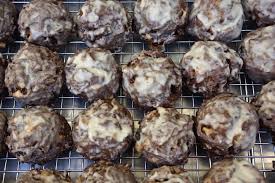 Moving on to cookies, chocolate hermits were “good, but I still like regular (non-chocolate) hermits better!” Possibly chocolate doesn’t make everything better? Classic rugelach turned into quite a project for the two who tried them– they were “fussy and messy to make,” and had “so many steps….so many small bowls [for the filling ingredients].” In the end, despite good results, “I wouldn’t make them again.” David’s cookies were also a bit fussy to make, as the directions tell you to remove individual cookies from the sheets as they become done; the logistics of doing this (constantly opening the oven, trying to remove very hot cookies without damaging them or their neighbor) turned a fairly simple cookie recipe into a chore. Best chocolate chip cookies were yummy; these were the crispy type (rather than cakey or chewy– obviously “best” only applies if you prefer crispy!). Instructions tell you to wet your hands and then roll the dough into balls, but the dough was so soft that this made for a gooey mess. You are forewarned! But oatmeal molasses cookies were excellent, with a nice “caramelly” flavor.
Moving on to cookies, chocolate hermits were “good, but I still like regular (non-chocolate) hermits better!” Possibly chocolate doesn’t make everything better? Classic rugelach turned into quite a project for the two who tried them– they were “fussy and messy to make,” and had “so many steps….so many small bowls [for the filling ingredients].” In the end, despite good results, “I wouldn’t make them again.” David’s cookies were also a bit fussy to make, as the directions tell you to remove individual cookies from the sheets as they become done; the logistics of doing this (constantly opening the oven, trying to remove very hot cookies without damaging them or their neighbor) turned a fairly simple cookie recipe into a chore. Best chocolate chip cookies were yummy; these were the crispy type (rather than cakey or chewy– obviously “best” only applies if you prefer crispy!). Instructions tell you to wet your hands and then roll the dough into balls, but the dough was so soft that this made for a gooey mess. You are forewarned! But oatmeal molasses cookies were excellent, with a nice “caramelly” flavor.  Brownies, a recipe that is closely identified with Maida Heatter, produced one hit and one miss; but both bakers would try them again. Plus, as instructed, “wrapping them individually worked great!”
Brownies, a recipe that is closely identified with Maida Heatter, produced one hit and one miss; but both bakers would try them again. Plus, as instructed, “wrapping them individually worked great!”
A few people were ambitious enough to make pies; the apple pie USA was a bit time consuming with its persnickety crust, but “everyone loved the pie!” Key lime pie had a wonderful gingersnap crust, and strawberry tart had a crust that “I use for any fruit tart.”
If you aren’t a Maida Heatter devotee, you wouldn’t have realized at first that all of the recipes in this book are published in her other titles, so if you have her other books you might not want to bother buying this one (you can get it from the library instead!). Despite some difficulties, our group on the whole enjoyed this book, and for those of us who weren’t so familiar with her, it was a nice introduction. But no cookbook is perfect; there were complaints that too many recipes contained walnuts; there was an overabundance of chocolate recipes (some of which seemed a bit too similar to each other), and some of her techniques were a bit unrealistic for us amateurs (beating egg whites by hand on a turkey platter!) Also we thought it odd that a pro like Ms. Heatter doesn’t weigh her ingredients. While it’s true that most American cooks still prefer volume measurements, weighing has made some inroads, and would have been appreciated by those of us who love our kitchen scales.
Our ups and downs were quite evident in our voting: a few at each end and most somewhere in the middle, so we averaged out to a 3.5 (out of 5). Be sure to join us at our next meeting – (coming right up!) – on Friday, January 31 at 11 AM in the Fireplace Room. We’ll be discussing one of the Chelmsford One Book selections, Ann Hood’s memoir Kitchen Yarns, as well as Bring It! by Ali Rosen. Copies are available at the main desk, all are welcome!
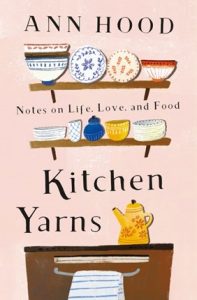
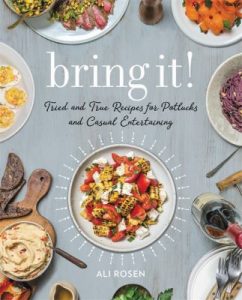
*Pronounced May-da, in case you were wondering.
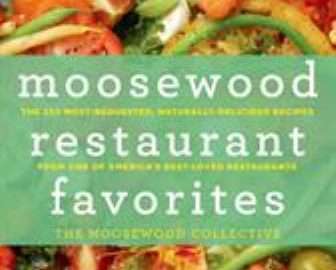
Bibliobites: Into the Woods
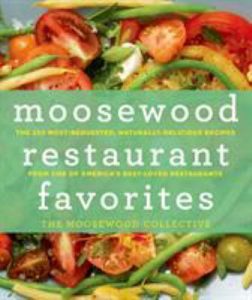 Anyone who remembers the 1970s will recall how food co-ops and “health food” restaurants popped up everywhere, seemingly overnight. Suddenly vegetables and whole grains assumed a greater importance than they had ever had on American tables; and though being a vegetarian was still seen as a fringe choice, attitudes slowly started to shift. Many first experienced this trend at a restaurant, and none illustrated it better than the Moosewood Restaurant in Ithaca, NY. Founded by a group of owners in 1973, this restaurant’s influence continues even today. Its reach has been amplified tremendously through more than a dozen cookbooks, the first of which was published in 1977, and the most recent in 2017. Recently, our Bibliobites group tackled two of these titles: Moosewood Restaurant Favorites from 2013, and The Moosewood Restaurant Table from 2017. Has Moosewood evolved along with the cuisine it has championed for more than four decades? We hit the produce section big-time in order to answer that question!
Anyone who remembers the 1970s will recall how food co-ops and “health food” restaurants popped up everywhere, seemingly overnight. Suddenly vegetables and whole grains assumed a greater importance than they had ever had on American tables; and though being a vegetarian was still seen as a fringe choice, attitudes slowly started to shift. Many first experienced this trend at a restaurant, and none illustrated it better than the Moosewood Restaurant in Ithaca, NY. Founded by a group of owners in 1973, this restaurant’s influence continues even today. Its reach has been amplified tremendously through more than a dozen cookbooks, the first of which was published in 1977, and the most recent in 2017. Recently, our Bibliobites group tackled two of these titles: Moosewood Restaurant Favorites from 2013, and The Moosewood Restaurant Table from 2017. Has Moosewood evolved along with the cuisine it has championed for more than four decades? We hit the produce section big-time in order to answer that question!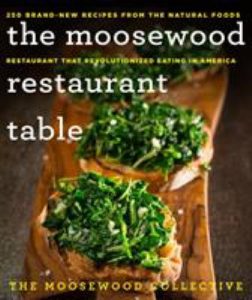
Both books (hereinafter referred to as RF and RT to save typing) garnered quite a bit of praise. They’re both hefty tomes with recipes that run the gamut from appetizers to dessert. RT has a separate “Breakfast” section, for those of you who are into brunch, as well as an on-trend “Bowls” chapter. RF features a section on fish for those “vegetarians” who are really pescatarians, as well as a chapter devoted to the oft-maligned tofu. Both books are nicely laid out with an easy to read typeface. The photos were appealing, but we all wished for more of them– though more would likely have made the books impossibly unwieldy.
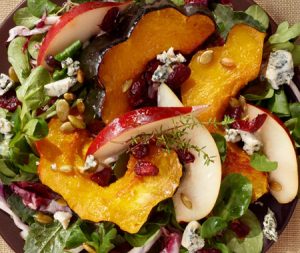 In the kitchen, we got busy! All of the following are from the RF title. The autumn salad plate with its roasted squash, cheddar, and pears was “our favorite.” Caribbean stew involved a lot of chopping to prep; it was good but “it had too much ginger for me.” Another stew, our best chili, was “a keeper…the contrast of the sweet corn and the other spices was pleasing.” Basque beans was also a winner, with its Spanish-inspired notes of saffron and sherry. Since soup season was getting started, we made a few: Southwestern sweet potato-corn soup was colorful and tasty, but it was a little on the thin side and needed something to add body—maybe some butter? Thai butternut squash soup was also delicious, but came in for some criticism because it used only half the can of coconut milk (what to do with the rest?), and was also vague on what kind of curry paste to use. Continuing with the orange theme, red lentil soup was a harmonious combination of flavors; this too was “a keeper!”
In the kitchen, we got busy! All of the following are from the RF title. The autumn salad plate with its roasted squash, cheddar, and pears was “our favorite.” Caribbean stew involved a lot of chopping to prep; it was good but “it had too much ginger for me.” Another stew, our best chili, was “a keeper…the contrast of the sweet corn and the other spices was pleasing.” Basque beans was also a winner, with its Spanish-inspired notes of saffron and sherry. Since soup season was getting started, we made a few: Southwestern sweet potato-corn soup was colorful and tasty, but it was a little on the thin side and needed something to add body—maybe some butter? Thai butternut squash soup was also delicious, but came in for some criticism because it used only half the can of coconut milk (what to do with the rest?), and was also vague on what kind of curry paste to use. Continuing with the orange theme, red lentil soup was a harmonious combination of flavors; this too was “a keeper!”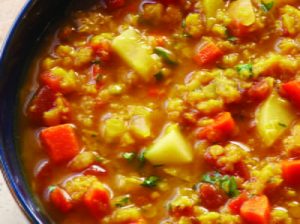
More from RF: a couple of us tried teriyaki fish and deemed it “boring.” It also had an unappealing color, which didn’t help matters. Creamy seafood stew was “OK—but I think I make a better one.” Better was oven-poached fish with leeks and wine; the leeks were tasty though they didn’t quite cook through by the time the fish was done. Not fried fish was a big hit: “really good! And so easy!” The crispy breadcrumbs and the Old Bay seasoning made for a winning combination. Caramelized onion pie was filled with “awesome” onions; it was delicious and reheated well. And spinach lasagna was yummy; best of all it was “so much quicker” than other lasagna recipes because neither the noodles or the spinach had to be cooked before assembly. One main dish’s name so intrigued three of us that we had to try it: 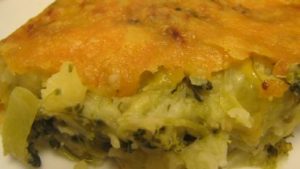 rumbledethumps, and we all loved it. It’s a casserole version of colcannon, a hearty mix of mashed potatoes and cabbage; in this recipe, there’s also broccoli and a cheese topping. Perfect as either a main dish or side. Speaking of sides, roasted Brussels sprouts were “surprisingly good” for an admitted sprouts skeptic, and gingered broccoli and carrots was “really good—and better the next day.” The ginger flavor was just right and was a good foil for the veggies. Greek lemony potatoes were pleasant though they could have used more lemon flavor, but “I would try them again.” We baked a few desserts, too: two of us tried vegan chocolate cake, which was good, though not outstanding; the chocolate flavor was a bit too mild for us. Cowboy cookies were just “OK” for one person, but others really enjoyed this hearty combination of oats, nuts, chocolate chips, and raisins; “one would fill you up for the day!”
rumbledethumps, and we all loved it. It’s a casserole version of colcannon, a hearty mix of mashed potatoes and cabbage; in this recipe, there’s also broccoli and a cheese topping. Perfect as either a main dish or side. Speaking of sides, roasted Brussels sprouts were “surprisingly good” for an admitted sprouts skeptic, and gingered broccoli and carrots was “really good—and better the next day.” The ginger flavor was just right and was a good foil for the veggies. Greek lemony potatoes were pleasant though they could have used more lemon flavor, but “I would try them again.” We baked a few desserts, too: two of us tried vegan chocolate cake, which was good, though not outstanding; the chocolate flavor was a bit too mild for us. Cowboy cookies were just “OK” for one person, but others really enjoyed this hearty combination of oats, nuts, chocolate chips, and raisins; “one would fill you up for the day!”
Some in the group also dipped into the RT book: award-winning chili with chocolate and stout was a winner. Mushrooms and lentils added tons of flavor; the one drawback of this recipe was that it had “so many ingredients!” which added significantly to the prep time. With it you could make carrot cornbread, which turned out a bit doughy (“I used the wrong flour”) but still tasted good; the grated carrots made this bread unique and enjoyable. 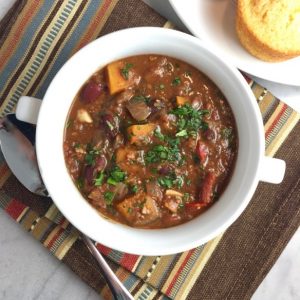 Winter squash and red bean mole was yet another iteration of chili that was nicely spicy, but “squash is a pain to cut up!” Squash was apparently on everyone’s radar (it was Fall after all): in addition to the chili, roasted winter squash agrodolce featured it, with two praiseworthy sauces– one spicy and one sweet. And white bean stew with rosemary was another savory melange of beans and veggies; it was “nice and thick,” but be sure you really like rosemary, as it was “assertive” in this dish. On the sweet side of things, cardamom cookies were a buttery treat; however, it was very difficult to grind the cardamom seeds, and unfortunately cardamom is quite expensive. But despite these obstacles, they were deemed good enough to try again. Lastly, Turkish coffee brownies had an odd, rough texture but since they tasted great it didn’t matter that much.
Winter squash and red bean mole was yet another iteration of chili that was nicely spicy, but “squash is a pain to cut up!” Squash was apparently on everyone’s radar (it was Fall after all): in addition to the chili, roasted winter squash agrodolce featured it, with two praiseworthy sauces– one spicy and one sweet. And white bean stew with rosemary was another savory melange of beans and veggies; it was “nice and thick,” but be sure you really like rosemary, as it was “assertive” in this dish. On the sweet side of things, cardamom cookies were a buttery treat; however, it was very difficult to grind the cardamom seeds, and unfortunately cardamom is quite expensive. But despite these obstacles, they were deemed good enough to try again. Lastly, Turkish coffee brownies had an odd, rough texture but since they tasted great it didn’t matter that much.
Overall, our group enjoyed and appreciated these two titles. If you’re at all interested in vegetables, it’s always nice to find inventive ways to prepare them; and since the Moosewood group has 40 years of experience making veggies taste their best, we were bound to find at least a few good ideas. There were, of course, a few complaints: an over-reliance on those two ’70s workhorses, coriander and cumin; some recipes depended a bit too much on copious quantities of butter and/or cheese; and a few recipes were just plain boring. But despite these caveats, most felt that the books reflected the best of modern vegetarian cuisine, and gave them doable and delicious ways to go meatless more often. Our voting echoed these good vibes: we averaged out to a 4.0 (out of a possible 5), which is one of the higher scores we’ve ever recorded. In another telling statistic, four people said they plan to buy one of the books. Road trip to Ithaca, anyone?
Please watch for our next Bibliobites roundup (coming soon!) where we’ll be talking sweets from Maida Heatter’s Happiness is Baking.
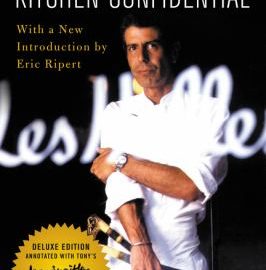
Recap of Bibliobites in September: Profound, Profane– Bourdain!
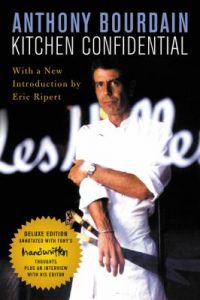 After a summer off, we met on a sunny September morning to dish (pun intended) about one of the food world’s most unique characters and its archetypal bad boy: Anthony Bourdain. In the New York City restaurant world of the 1990s, Bourdain was undoubtedly well-known; but his 2000 memoir, Kitchen Confidential, brought him national fame. His indelible descriptions of “the life,” as he calls it, along with his unsparing portraits of the people and places he encountered along the way, provide a wide-open window into the inner workings of an industry—and have enlightened, entertained, and terrified restaurant-goers in equal measure. This title has become a classic in its genre; but does it still appeal almost twenty years after its publication?
After a summer off, we met on a sunny September morning to dish (pun intended) about one of the food world’s most unique characters and its archetypal bad boy: Anthony Bourdain. In the New York City restaurant world of the 1990s, Bourdain was undoubtedly well-known; but his 2000 memoir, Kitchen Confidential, brought him national fame. His indelible descriptions of “the life,” as he calls it, along with his unsparing portraits of the people and places he encountered along the way, provide a wide-open window into the inner workings of an industry—and have enlightened, entertained, and terrified restaurant-goers in equal measure. This title has become a classic in its genre; but does it still appeal almost twenty years after its publication?
To start, let’s get the obvious out of the way: Bourdain has an incredible (as one of our members put it) “potty mouth.” He’s eminently quotable, but often those quotes must be censored in publications because of his love of four-letter words. This #@%! habit didn’t seem to bother our group too much, as his choice of words seemed consistent with his personality and the situations he was describing. Most really enjoyed his writing style and thought he was an excellent writer, which begged the question: is he more of a writer or a chef? These aren’t mutually exclusive talents, of course, but it was fun to debate—and the question returned when we discussed our experiences with his cookbook (see below). Many of Bourdain’s chapters focus on his “bad behavior;” and though we admired his unsparing truthfulness about his shortcomings, the bad boy shtick did get a little old. Since our group read the memoir Sous Chef a few years ago, we weren’t totally surprised by Bourdain’s descriptions of the daily grind in a restaurant kitchen, but the culture of crazed super-macho masculinity that he so vividly portrays still has the power to shock. How this type of kitchen culture developed, and why it remains so prevalent would make for a fascinating anthropological study! Though Bourdain himself admits (in the chapter about chef Scott Bryan) that not every place is so “dysfunctional,” it does seem to be the rule rather than the exception; and Bourdain clearly embraces and enjoys the chaos.
Despite his self-reported shortcomings, most in our group admire Bourdain. He was a person who was uniquely and supremely himself, and that always appeals. Many are devotees of his various TV shows (No Reservations seemed to be the overall favorite); loved for their adventurous and no-holds-barred approach. His untimely death in 2018 has only brought his contributions to the world of food into sharper focus (check out the tributes in Anthony Bourdain Remembered). Our appreciation was reflected in our voting: we averaged out to a 4.67 out of a possible 5, probably the highest score ever for this group!
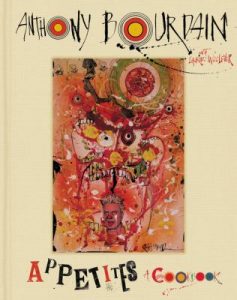 Though we may perhaps now think of Bourdain mostly as a writer and world traveler, he was first a cook—but interestingly, he’s written very few cookbooks (those who can, do; those who can’t, write cookbooks?). However he did publish one in 2016: Appetites, which our group reviewed. Bourdain writes in his introduction that these are the dishes he likes to eat, and to make for family and friends. He says, “…there is nothing remotely innovative about the recipes in this book,” and overall, our group had to agree! Beef goulash was “totally not unique” and the meat somehow never became tender. The black bean soup was “fine, not fabulous;” the chorizo in it was tasty but somehow didn’t “go” with the other flavors in the dish. A few other recipes were deemed okay but not exceptional: roasted baby beets with red onion and orange were pretty much basic roasted beets; Belgian endive with curried chicken salad was (as described in the headnote) “…1970 called….;” and tomato salad was, like the beets, a basic combination. Mushrooms sautéed with shallots was just that; and the ratatouille was good, but “too fussy,” as all the vegetables were cooked individually. It was better the next day, though, so at least there were enjoyable leftovers! One complete flop was the grill bitch’s bar nuts; these completely refused to dry out, and then burned, perhaps due to a too-high (325 degrees) oven temperature?
Though we may perhaps now think of Bourdain mostly as a writer and world traveler, he was first a cook—but interestingly, he’s written very few cookbooks (those who can, do; those who can’t, write cookbooks?). However he did publish one in 2016: Appetites, which our group reviewed. Bourdain writes in his introduction that these are the dishes he likes to eat, and to make for family and friends. He says, “…there is nothing remotely innovative about the recipes in this book,” and overall, our group had to agree! Beef goulash was “totally not unique” and the meat somehow never became tender. The black bean soup was “fine, not fabulous;” the chorizo in it was tasty but somehow didn’t “go” with the other flavors in the dish. A few other recipes were deemed okay but not exceptional: roasted baby beets with red onion and orange were pretty much basic roasted beets; Belgian endive with curried chicken salad was (as described in the headnote) “…1970 called….;” and tomato salad was, like the beets, a basic combination. Mushrooms sautéed with shallots was just that; and the ratatouille was good, but “too fussy,” as all the vegetables were cooked individually. It was better the next day, though, so at least there were enjoyable leftovers! One complete flop was the grill bitch’s bar nuts; these completely refused to dry out, and then burned, perhaps due to a too-high (325 degrees) oven temperature?
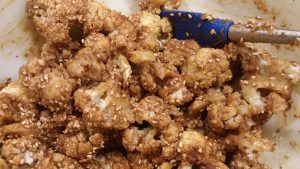 On the more positive side, pomodoro sauce was “light…easy, and good!” It was used in the meatball parm hero, which had tasty meatballs (“liked the veal in them, and the herbs”), and made plenty. Roasted cauliflower with sesame was a flavorful treatment for this now-popular vegetable, but only if you like tahini and don’t mind a finished dish in an unappealing khaki color! Macaroni and cheese was “awesome—super-cheesy and rich. I could taste all the different cheeses!” And
On the more positive side, pomodoro sauce was “light…easy, and good!” It was used in the meatball parm hero, which had tasty meatballs (“liked the veal in them, and the herbs”), and made plenty. Roasted cauliflower with sesame was a flavorful treatment for this now-popular vegetable, but only if you like tahini and don’t mind a finished dish in an unappealing khaki color! Macaroni and cheese was “awesome—super-cheesy and rich. I could taste all the different cheeses!” And 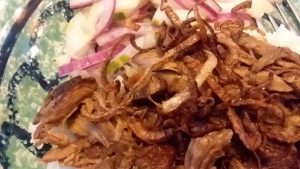 braised pork shoulder with fried shallots and pickled vegetables was a winning combination; the piquant vegetables contrasted beautifully with the savory pork. This dish was a bit of work, but it made a lot, and the leftovers improved with age.
braised pork shoulder with fried shallots and pickled vegetables was a winning combination; the piquant vegetables contrasted beautifully with the savory pork. This dish was a bit of work, but it made a lot, and the leftovers improved with age.
As noted, this book didn’t contain much that was new and/or different. Most of us already have similar recipes for many of the dishes in it, and Bourdain’s variations weren’t enticing enough to make us switch. The book itself is an interesting read; the photography is unique (some might say peculiar) among cookbooks, and the cover painting is equally uncommon. It’s almost more of an art book than a cookbook, and reflects Bourdain’s persona. However, it’s what comes out of the kitchen that counts, and in that respect it didn’t make the grade: our voting averaged out to a 2.1 (out of a possible 5). So, maybe we wouldn’t want to cook with Bourdain, but we’d sure love to chat or travel with him. Sadly that’s not possible; but we’ll continue to enjoy his books and videos in the future.
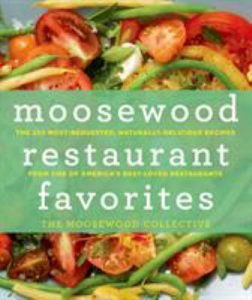 Our next meeting will be on Friday, October 25 at 11 AM in the Fireplace Room. We’ll be discussing Moosewood Restaurant Favorites by the Moosewood Collective. The Moosewood Restaurant in Ithaca, NY has been in the vanguard of vegetarian cuisine for almost 40 years— is their food still exceptional? And is the meatless lifestyle for you? Pick up a copy at the main desk and then join our discussion on the 25th; all are welcome!
Our next meeting will be on Friday, October 25 at 11 AM in the Fireplace Room. We’ll be discussing Moosewood Restaurant Favorites by the Moosewood Collective. The Moosewood Restaurant in Ithaca, NY has been in the vanguard of vegetarian cuisine for almost 40 years— is their food still exceptional? And is the meatless lifestyle for you? Pick up a copy at the main desk and then join our discussion on the 25th; all are welcome!
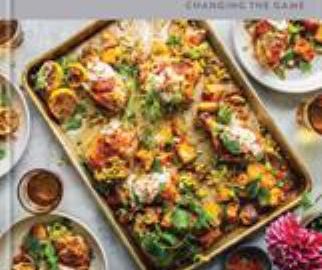
Bibliobites in April: Game On! Dinner, Part 1
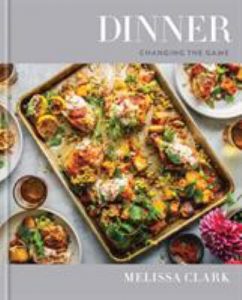 Even for those of us who enjoy cooking, making dinner every night can be a bit of a slog. You want to eat something interesting– but nothing too complicated because it’s a weeknight. And the recipe better use ingredients you already have in the house, because who in their right mind would go to a grocery store at 5 PM? Also it should be reasonably quick, and preferably with a streamlined cooking method that won’t have you dirtying three pots and five bowls, because dish-washing is definitely less fun than cooking. And of course it must taste fabulous; bonus points if it creates leftovers that everyone fights over for lunch. All of the above requirements might seem like a tall order; but when you consider the number of cookbooks devoted to the evening meal, it seems that cookbook authors are up for the challenge.
Even for those of us who enjoy cooking, making dinner every night can be a bit of a slog. You want to eat something interesting– but nothing too complicated because it’s a weeknight. And the recipe better use ingredients you already have in the house, because who in their right mind would go to a grocery store at 5 PM? Also it should be reasonably quick, and preferably with a streamlined cooking method that won’t have you dirtying three pots and five bowls, because dish-washing is definitely less fun than cooking. And of course it must taste fabulous; bonus points if it creates leftovers that everyone fights over for lunch. All of the above requirements might seem like a tall order; but when you consider the number of cookbooks devoted to the evening meal, it seems that cookbook authors are up for the challenge.
Which bring us to this month’s title, Melissa Clark’s Dinner: Changing the Game. Ms. Clark, a NY Times columnist and the author of several well-received cookbooks, maintains that not only can she change our dinner game, she can improve upon it– considerably! That’s a claim our group was happy to put to the test.
We definitely gave the author points for the design of the book; there were plenty of outstanding full-page photos, and almost all the recipes fit on one page. The book has that size that now seems to be the new standard: about the size of a sheet of paper (I got curious and actually measured the book: it’s 8 1/4″ by 10 1/4″). Lately we’ve noticed that some books have headnotes that are, shall we say, extensive; this title was praised for its helpful and not overly verbose intros. So, things were literally looking good; but how did it go when we were staring down the stove at 6 PM?
 As always, chicken dishes were a popular choice to try; both sesame chicken with cashews and dates and Vietnamese ginger chicken were praised for being easy and tasty. Thai chicken breasts and mustard chicken breasts also earned thumbs up; the mustard chicken had an assertive tangerine flavor that was particularly enjoyable. Pizza chicken, despite its enticing name, was “just OK;” it needed to have more of a sauce than it did. We made a fair amount of seafood, as well: Vietnamese caramel salmon was loaded with pungent umami, and the shrimp pad thai was a pleasantly vegetable-centric version of this classic dish. But fish tacos were “blah” and needed more spice. The coleslaw that went with it was delicious, though!
As always, chicken dishes were a popular choice to try; both sesame chicken with cashews and dates and Vietnamese ginger chicken were praised for being easy and tasty. Thai chicken breasts and mustard chicken breasts also earned thumbs up; the mustard chicken had an assertive tangerine flavor that was particularly enjoyable. Pizza chicken, despite its enticing name, was “just OK;” it needed to have more of a sauce than it did. We made a fair amount of seafood, as well: Vietnamese caramel salmon was loaded with pungent umami, and the shrimp pad thai was a pleasantly vegetable-centric version of this classic dish. But fish tacos were “blah” and needed more spice. The coleslaw that went with it was delicious, though!
Other meaty mains we made included the excellent and easy 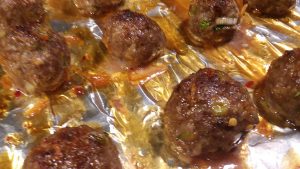 marmalade meatballs, and a “really good” lamb stew. Pork scallopini were perfectly accented by the traditional apples; the cook confessed she didn’t use the called-for anchovies, which might have altered the overall flavor profile a bit! But Georgian lamb kebabs were a disappointment, as the spice combination did not appeal, and the dill sauce was more relish than sauce. Interestingly, the photo of this recipe does show a chopped relish, but the text calls it “dill sauce.”
marmalade meatballs, and a “really good” lamb stew. Pork scallopini were perfectly accented by the traditional apples; the cook confessed she didn’t use the called-for anchovies, which might have altered the overall flavor profile a bit! But Georgian lamb kebabs were a disappointment, as the spice combination did not appeal, and the dill sauce was more relish than sauce. Interestingly, the photo of this recipe does show a chopped relish, but the text calls it “dill sauce.”
Many of us were pleased to discover that this title featured plenty of vegetarian options, in several categories! Winners included the sweet potato dhal, which was “solidly good.” Though it wasn’t authentic, it was a lot speedier to make than the traditional version, so it was a worthwhile trade-off for a weeknight meal. Black bean skillet dinner was a good combination, but what really put it over the top were the flavor-packed garnishes of pickled red onions and lime crema. The Farro and crispy leeks recipe was likewise easy and tasty, and it made a lot– nice for leftovers. Two styles of fritters were also hits: the zucchini-cornmeal cakes and the fresh corn cakes. While these were designed as dinner entrees, they would make lovely appetizers as well. Fried halloumi with spicy brussels sprouts was an unexpectedly delicious combination; on the downside, halloumi is quite pricey, and adding the halloumi to a hot skillet caused it to spit all over the place! Curried lentils had an amazingly enticing flavor that only improved with age;  butternut squash pizza likewise showcased bold flavors with its lemon, manchego, and squash topping.
butternut squash pizza likewise showcased bold flavors with its lemon, manchego, and squash topping.
A few flops in this category included asparagus carbonara, which turned out to be “asparagus with scrambled eggs,” not necessarily a bad thing but maybe not what the cook intended! However, “it tasted great!” Stovetop fusilli with spinach, peas, and gruyere also did not turn out as advertised; though the recipe promised a dish with creamy sauce, the gruyere melted into a rubbery, stringy mass laced with spinach that then had to be chopped into bits in order to eat it. Also in cheese mode, gruyere frittata was “kind of bland” and not as substantial as frittatas typically are; it “needed something– maybe bacon? Potatoes?” 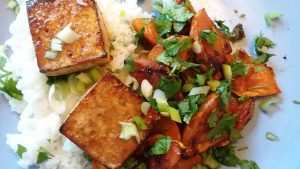 Maple-roasted tofu had a really yummy marinade; unfortunately the marinade never really penetrated the tofu and it tasted a bit too much like plain tofu. But the marinade was wonderful on the squash.
Maple-roasted tofu had a really yummy marinade; unfortunately the marinade never really penetrated the tofu and it tasted a bit too much like plain tofu. But the marinade was wonderful on the squash.
Our overall impression of this book was one of weighing lots of pluses with plenty of minuses. On the plus side, many of the dishes were quick, tasty, and a cut above the ordinary– which is the author’s stated goal. However, since this book is pitched as a weeknight solution, we thought that goal wasn’t always attained. A significant number of recipes had long lists of ingredients, or called for things we didn’t have or weren’t easy to find, or were expensive. There were lots of interesting dipping sauces and garnishes, but these added to prep and cooking time, which could be a negative on a work day. We also noted that Ms. Clark used a few ingredients a bit too regularly, among them fresh sage and lentils. She also relies extensively on fresh herbs– not a bad thing, but something that doesn’t keep that well and that you are therefore not likely to have hanging around in your fridge. And, as mentioned before, we might prefer to avoid the post-work grocery run! Ms. Clark also states that most recipes are a one-dish solution, but we didn’t find that to be true as much as we would have liked. Recipe timing also came in for some criticism; it turns out that the “total time” listed in the recipe is time after all prep is complete!
Once again our voting reflected our yin and yang: we averaged out to a 3.2 (out of a possible 5). Two people liked the book enough that they would buy it, but “only at a discount!” Perhaps that sums it up best!
Join us at our next meeting, Friday May 31 at 11 AM in the Fireplace Room, when we’ll discuss Dinner Part 2: Sara Moulton’s Home Cooking 101: How to Make Everything Taste Better. Copies are available at the main desk. Hope to see you there!
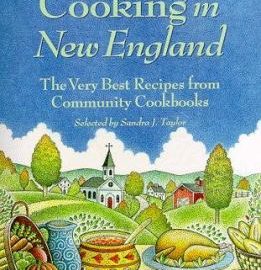
Bibliobites in March: A Clutch of Community Cookbooks
For people who love to cook, talking about food and sharing recipes is just as much fun (sometimes more fun!) as baking, grilling, or stir-frying. That impulse to share often expresses itself in cookbooks produced by community groups, whether churches, schools, social clubs, or even libraries! This month we took a look at several titles, most self-published, some traditionally published– but all providing a fascinating peek at real-life cooking.
 Many of the locally-produced titles we reviewed were printed in the 1980s and 1990s. Those of us of a certain age may recall that this was the first time that books could be semi-professionally created with “desktop publishing” software, and it was obvious that many groups took advantage of this then-new technology. But having the ability to create something doesn’t always translate to an excellent product; and there were numerous complaints about recipes that were lacking ingredients or complete instructions, or that just didn’t work– since they probably weren’t tested. Books from this era were repeatedly described using the word “dated,” as they often suffered from an over-reliance on, for instance, cream of mushroom soup or non-dairy whipped topping. But almost everyone did appreciate that the recipes were mostly simple and used readily available ingredients. Some of the titles I’ll mention are member’s personal copies or out-of-print, and as such are unavailable in our consortium. But perhaps you have a few of these lurking on your shelves somewhere– maybe it’s time to dust them off and try a few recipes, as we found some hits among a fair number of misses!
Many of the locally-produced titles we reviewed were printed in the 1980s and 1990s. Those of us of a certain age may recall that this was the first time that books could be semi-professionally created with “desktop publishing” software, and it was obvious that many groups took advantage of this then-new technology. But having the ability to create something doesn’t always translate to an excellent product; and there were numerous complaints about recipes that were lacking ingredients or complete instructions, or that just didn’t work– since they probably weren’t tested. Books from this era were repeatedly described using the word “dated,” as they often suffered from an over-reliance on, for instance, cream of mushroom soup or non-dairy whipped topping. But almost everyone did appreciate that the recipes were mostly simple and used readily available ingredients. Some of the titles I’ll mention are member’s personal copies or out-of-print, and as such are unavailable in our consortium. But perhaps you have a few of these lurking on your shelves somewhere– maybe it’s time to dust them off and try a few recipes, as we found some hits among a fair number of misses!
Several in our group own books that were produced by Chelmsford organizations: the Garrison House’s Cookie Book; Aldersgate Church’s Seasoned With Love; the Unitarian Church Cookbook (from 1949!); and the South Chelmsford Village Improvement Association Cookbook. One tasty dish from the Aldersgate book, 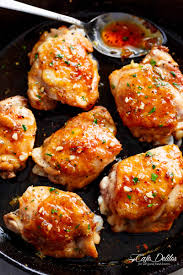 chicken with honey and orange, was a combination of only 4 ingredients (chicken, honey, orange juice and onions). The method needed a bit of tweaking, but the whole was definitely greater than the sum of its parts. Our neighbor Westford produced Westford Kitchens, which also seemed quite dated, though it was produced in 2003. But this book had the famous Jordan Marsh blueberry muffin recipe, which is “the best!” Interestingly the recipe only called for one cup of blueberries, which didn’t seem like enough. Beth Ann’s Best, a book from a Framingham synagogue, had an excellent carrot cake recipe with a “really good” frosting. But this late 1950s book featured lots of lard and sugar, which doesn’t appeal to everyone! And we all got a good laugh from a book published by a Maryland church that had lengthy, detailed instructions for baked plump possum; the recipe ended with “send out for pizza!”
chicken with honey and orange, was a combination of only 4 ingredients (chicken, honey, orange juice and onions). The method needed a bit of tweaking, but the whole was definitely greater than the sum of its parts. Our neighbor Westford produced Westford Kitchens, which also seemed quite dated, though it was produced in 2003. But this book had the famous Jordan Marsh blueberry muffin recipe, which is “the best!” Interestingly the recipe only called for one cup of blueberries, which didn’t seem like enough. Beth Ann’s Best, a book from a Framingham synagogue, had an excellent carrot cake recipe with a “really good” frosting. But this late 1950s book featured lots of lard and sugar, which doesn’t appeal to everyone! And we all got a good laugh from a book published by a Maryland church that had lengthy, detailed instructions for baked plump possum; the recipe ended with “send out for pizza!”
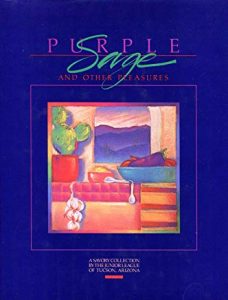 Some of our books were professionally published; two of these were published by Junior Leagues, one in Tucson AZ in 1986, and the other in Portland ME in 1982. The Portland book, RSVP, was highly praised for its “fabulous” New York cheesecake and its “very sweet but yummy” poppy seed tea bread. Also hits: the sweet potato souffle and “the best blue cheese dressing ever!” The Tucson book, Purple Sage and Other Pleasures had some fantastic vegetable recipes: purple cabbage, honey baked onions, and marinated asparagus; all received an enthusiastic thumbs-up. This book in particular seemed quite professional, with healthy, practical recipes that were easy to make.
Some of our books were professionally published; two of these were published by Junior Leagues, one in Tucson AZ in 1986, and the other in Portland ME in 1982. The Portland book, RSVP, was highly praised for its “fabulous” New York cheesecake and its “very sweet but yummy” poppy seed tea bread. Also hits: the sweet potato souffle and “the best blue cheese dressing ever!” The Tucson book, Purple Sage and Other Pleasures had some fantastic vegetable recipes: purple cabbage, honey baked onions, and marinated asparagus; all received an enthusiastic thumbs-up. This book in particular seemed quite professional, with healthy, practical recipes that were easy to make.
A few books provided a window into a different place or time. The Southern Foodways Alliance Community Cookbook, published by the University of Mississippi in 2010, is an eye-opener for a New Englander: a full chapter devoted to all types of gravy, for one! Interestingly there were no recipes using beef, but plenty of fish and pork, including deep-fried bacon. Hits included a savory creamy corn pudding, and spicy turnip greens, which featured tomato, garlic, onion and one tablespoon of cayenne pepper! Carolina coleslaw was tasty, though the dressing had “so many” ingredients, including a whopping 1 1/2 cups of oil. 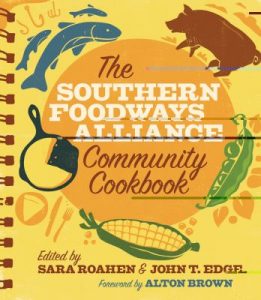 Liquid pork certainly had an intriguing name; this dish proved to be an all-day adventure involving (among other things) smoke detectors going off! The result was “really good,” but it was such a production that the experience probably won’t be repeated.
Liquid pork certainly had an intriguing name; this dish proved to be an all-day adventure involving (among other things) smoke detectors going off! The result was “really good,” but it was such a production that the experience probably won’t be repeated.
Returning to more familiar ground, the New England Innkeeper’s Cookbook, a compilation published by Yankee Magazine, had some definite hits: squash muffins had good squash flavor and aged well; Southwest strata was a tasty combo of tortillas, beans, spinach, mushrooms, cheese, and sausage; and Jarlsberg vegetable bisque was “the best soup ever,” a magical combination of broccoli, carrots, celery, onions, and plenty of cream and cheese. Perfect for a raw, late-winter day. The only flop was the colossal cookies, which weren’t very good– they were quite dry, perhaps because the only dry ingredient was rolled oats. Hometown Cooking in New England had a nice collection of classic, simple recipes; the pumpkin muffins were “wonderful;” but the squash soup had “too much curry!” Best of the Best From New England was in a similar vein; the squash yeast bread was unexpectedly delicious and made lovely, aromatic toast (we must have all been in squash mode!); and tomato cognac soup was a delicious, sophisticated version of this classic. It was easy to make and definitely kicked it up a notch. But golden Parmesan potatoes, despite their enticing name, were fairly boring.
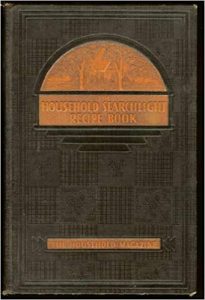 This month’s theme prompted a few people to revisit some ancient culinary history– one person re-read her mom’s Household Searchlight, a book published by Household magazine in the 1930s. Another member perused her mom’s hand-typed personal recipe book from around 1940, and decided to make war cake, a popular treat of that era; so named because it contains no butter, eggs or milk, which were rationed during WWII. So, vegan alert– baking without eggs isn’t a new thing! Some of these older books also contain recipes for cleaning products, and in this category as well, we discovered that what’s old is new again, as several household recipes used vinegar as the main ingredient– still valued for its effectiveness and non-toxicity. Though we didn’t rate any of our books, most people thought it was a fun project to explore these “cultural artifacts!”
This month’s theme prompted a few people to revisit some ancient culinary history– one person re-read her mom’s Household Searchlight, a book published by Household magazine in the 1930s. Another member perused her mom’s hand-typed personal recipe book from around 1940, and decided to make war cake, a popular treat of that era; so named because it contains no butter, eggs or milk, which were rationed during WWII. So, vegan alert– baking without eggs isn’t a new thing! Some of these older books also contain recipes for cleaning products, and in this category as well, we discovered that what’s old is new again, as several household recipes used vinegar as the main ingredient– still valued for its effectiveness and non-toxicity. Though we didn’t rate any of our books, most people thought it was a fun project to explore these “cultural artifacts!”
We’ll next meet on Friday, April 26 at 11 AM in the Fireplace Room. We’ll be discussing Dinner: Changing the Game by Melissa Clark. Was this title a game changer, or was it game over? All are welcome, hope to see you there!
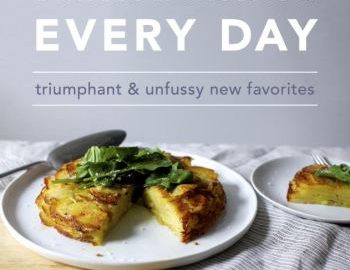
Bibliobites in February: Still Smitten?
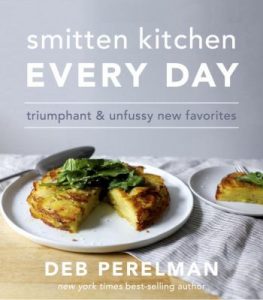 Long-time blogger Deb Perelman has been on our group’s radar before– way back in March of 2014, we reviewed her first cookbook, 2012’s bestseller The Smitten Kitchen Cookbook. Five years later, we checked out her latest effort, Smitten Kitchen Every Day: Triumphant and Unfussy New Favorites. We enjoyed that first book– but this time around, were we still smitten, or has Ms. Perelman suffered a sophomore slump?
Long-time blogger Deb Perelman has been on our group’s radar before– way back in March of 2014, we reviewed her first cookbook, 2012’s bestseller The Smitten Kitchen Cookbook. Five years later, we checked out her latest effort, Smitten Kitchen Every Day: Triumphant and Unfussy New Favorites. We enjoyed that first book– but this time around, were we still smitten, or has Ms. Perelman suffered a sophomore slump?
We were united in our praise for the book itself. Like its predecessor, it has a large-format – with heavy, glossy paper and absolutely stunning photography, shot by the author. Though some of us detested the long, chatty headnotes and others adored them, we all agreed that the writing was outstanding. The book seemed a bit “blog-ish;” in some ways we felt the writing took precedence over the recipes! The overall tone is humorous and self-deprecating; the author wants us to know she’s a regular person with the typical challenges of any cook in a kitchen, learning through time and experience. While it can certainly be appealing to know an author is more of a peer than a professional, when it comes to recipes we want to know they’ve been thoroughly vetted….and preferably unfussy as advertised. So, into the kitchen we go!
As the book does, let’s begin with breakfast: granola biscotti were crunchy– maybe a bit too crunchy– they “needed to be dunked.” But despite the crunch factor: “loved ’em.” Magical two-ingredient oat brittle was quite tasty (and easy) but it was so crunchy that it was a potential tooth-breaker. Please use caution when consuming! Spinach, mushroom, and goat cheese slab frittata came in for faint praise: it was “decent;” the cook felt it needed the punch of a more strongly-flavored cheese. Two of us tried the 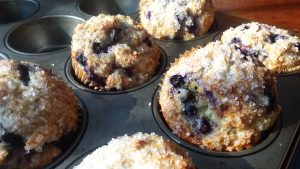 perfect blueberry muffins; one person’s looked like the tempting photo in the book, but another’s came out disappointingly flat. These were good muffins, and scored points for not being too sweet, but “you can’t beat the Jordan Marsh blueberry muffin recipe.” So, a worthy attempt but maybe not perfect for us!
perfect blueberry muffins; one person’s looked like the tempting photo in the book, but another’s came out disappointingly flat. These were good muffins, and scored points for not being too sweet, but “you can’t beat the Jordan Marsh blueberry muffin recipe.” So, a worthy attempt but maybe not perfect for us!
Many of us were excited and intrigued by the salad recipes; for example, potatoes and asparagus gribiche was a delicious combination of flavors, though “it was a lot of work” to assemble. Winter slaw with farro was a tasty way to add cool crunch on the side of your plate; but carrot salad with tahini, crisped chickpeas, and salted pistachios, though it sounded enticing, was “bland,” and the chickpeas never got crispy.
Besides the salads, there were plenty of vegetable-centric dishes in the book, which we appreciated. 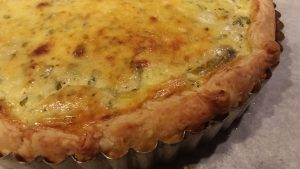 Artichoke and Parmesan galette was a quiche-ish tart that was loaded with artichokes; its flavors were a riff on the addictive fifties-era warm artichoke dip that had a rebirth in the 90’s. Wild mushroom shepherd’s pie had lots of savory umami from its two pounds of mushrooms (!), and improved on the second day; unfortunately it was also a “labor-intensive” recipe. One-pan farro with tomatoes is one of the most raved-about recipes on Ms. Perelman’s blog, and those who made it had to agree that it was super. It truly was unfussy and definitely delivered in the flavor department; also, “the fresh basil added a lot!” But broccoli, cheddar, and wild rice fritters were just “OK.” They weren’t quite substantial enough for a meal and they were messy to fry. “They needed a sauce,” too. Brussels and three cheese pasta bake was certainly hearty enough; but as is true of many of these types of casseroles, “it was a lot of work!” Our cook did like that the sauce was made with vegetable broth (instead of a dairy product) and was spiked with lemon zest. A couple of people tried
Artichoke and Parmesan galette was a quiche-ish tart that was loaded with artichokes; its flavors were a riff on the addictive fifties-era warm artichoke dip that had a rebirth in the 90’s. Wild mushroom shepherd’s pie had lots of savory umami from its two pounds of mushrooms (!), and improved on the second day; unfortunately it was also a “labor-intensive” recipe. One-pan farro with tomatoes is one of the most raved-about recipes on Ms. Perelman’s blog, and those who made it had to agree that it was super. It truly was unfussy and definitely delivered in the flavor department; also, “the fresh basil added a lot!” But broccoli, cheddar, and wild rice fritters were just “OK.” They weren’t quite substantial enough for a meal and they were messy to fry. “They needed a sauce,” too. Brussels and three cheese pasta bake was certainly hearty enough; but as is true of many of these types of casseroles, “it was a lot of work!” Our cook did like that the sauce was made with vegetable broth (instead of a dairy product) and was spiked with lemon zest. A couple of people tried 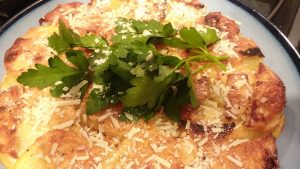 cacio e pepe potatoes Anna, which are pictured on the book’s cover. These were good, but not outstanding; and so perhaps not worth the effort. And sadly our attempts didn’t look nearly as gorgeous as the photo!
cacio e pepe potatoes Anna, which are pictured on the book’s cover. These were good, but not outstanding; and so perhaps not worth the effort. And sadly our attempts didn’t look nearly as gorgeous as the photo!
We tried a few meaty main dishes: smoky sheet pan chicken with cauliflower was easy to put together, and the marinade for the chicken was excellent.  Chicken and rice street cart style also had a fabulous marinade (really more of a rub) and the combination of chicken, rice, and chopped salad was worthy of any food truck. Quick sausage, kale, and crouton saute could’ve (amazingly) used more kale; and overall just needed more something. But it did still taste good, and was pretty speedy to produce. Meatballs Marsala with egg noodles and chives was a winner– the meatballs were delicious and moist, and easy to put together; “will definitely make again!”
Chicken and rice street cart style also had a fabulous marinade (really more of a rub) and the combination of chicken, rice, and chopped salad was worthy of any food truck. Quick sausage, kale, and crouton saute could’ve (amazingly) used more kale; and overall just needed more something. But it did still taste good, and was pretty speedy to produce. Meatballs Marsala with egg noodles and chives was a winner– the meatballs were delicious and moist, and easy to put together; “will definitely make again!”
When it came time for dessert, there was plenty of enthusiasm for baking all kinds of treats. Banana bread roll was easy to make and super-yummy; a keeper! Peach Melba popsicles were deliciously tart and creamy, and would probably be even more appreciated on a hot summer day.  Two thick, chewy oatmeal raisin chocolate chip mega-cookies were an interesting concept (with a way too long name–c’mon, Deb!)– the recipe really did make only two large cookies. Some liked the idea of only making a few cookies at a time; others thought this concept was a waste of effort. One person thought the cookies were a bit bland; they did have less sugar than your average cookie so that may have had an effect on taste perception. And the next day, the cookies were either “better” or “soggy,” depending on who you asked! Olive oil shortbread with rosemary and chocolate chunks, despite the chocolate, tasted “more savory than sweet,” but it could go either way. Rosemary haters should beware– the flavor was assertive! On the down side, double coconut meltaways looked nothing like the pretty, plump cookies in the photo; they came out flat and “greasy”– it seemed like there was way too much coconut oil in the recipe. And spice cake looked awesome and sliced neatly– but inside it was gummy (despite sworn faithful adherence to the recipe) and tasted oddly bland. Even the frosting became gummy on the second day.
Two thick, chewy oatmeal raisin chocolate chip mega-cookies were an interesting concept (with a way too long name–c’mon, Deb!)– the recipe really did make only two large cookies. Some liked the idea of only making a few cookies at a time; others thought this concept was a waste of effort. One person thought the cookies were a bit bland; they did have less sugar than your average cookie so that may have had an effect on taste perception. And the next day, the cookies were either “better” or “soggy,” depending on who you asked! Olive oil shortbread with rosemary and chocolate chunks, despite the chocolate, tasted “more savory than sweet,” but it could go either way. Rosemary haters should beware– the flavor was assertive! On the down side, double coconut meltaways looked nothing like the pretty, plump cookies in the photo; they came out flat and “greasy”– it seemed like there was way too much coconut oil in the recipe. And spice cake looked awesome and sliced neatly– but inside it was gummy (despite sworn faithful adherence to the recipe) and tasted oddly bland. Even the frosting became gummy on the second day.
In the final analysis, we realized that we loved most of her ideas— at first blush, lots of the recipes in this book seemed more interesting than most, yet approachable. However, in actual practice there was less triumph and more fussy than we would have liked. But, needless to say, everyone’s concept of what constitutes “fussy” is different, as it all depends on your overall cooking style and/or how much time and patience you have. A few people commented that they thought her first book was better, but generally almost everyone found something to enjoy in this title. Our voting was almost evenly split between those who gave it a 4 (out of 5) and those who gave it a 3; our average worked out to 3.25. So maybe we got pretty close to smitten!
Our next meeting will be on Friday, March 29 at 11 AM in the Fireplace Room. This month we’ll be perusing a variety of community cookbooks, including one produced by CPL staff several years ago. Choose one from those available at the main desk. New members always welcome; see you there!
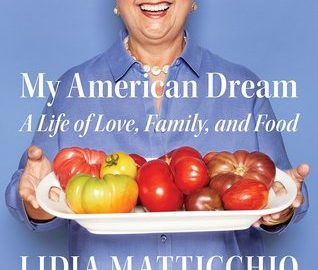
Bibliobites in January: We Heart Lidia
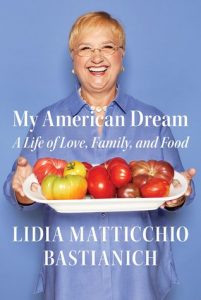 The multi-faceted and multi-talented Lidia Bastianich never ceases to amaze. With six restaurants to her name (some in partnership with son Joe); five outposts of the Italian mega-market, Eataly; numerous PBS television series; at least fifteen cookbooks; and a vineyard in Italy, only one conclusion is possible: the woman must not sleep. Ever. This month’s title, My American Dream (written by Lidia herself, of course!) is her fascinating and perhaps uniquely American story of unbelievably hardworking immigrants who achieve success in a big, big way.
The multi-faceted and multi-talented Lidia Bastianich never ceases to amaze. With six restaurants to her name (some in partnership with son Joe); five outposts of the Italian mega-market, Eataly; numerous PBS television series; at least fifteen cookbooks; and a vineyard in Italy, only one conclusion is possible: the woman must not sleep. Ever. This month’s title, My American Dream (written by Lidia herself, of course!) is her fascinating and perhaps uniquely American story of unbelievably hardworking immigrants who achieve success in a big, big way.
Those of us who read this memoir thoroughly enjoyed it. Most of us hadn’t known that Lidia and her family came to the US in the late 1950s as refugees from Communist Yugoslavia. The family’s struggles to adapt to their new culture, with its different language, food and customs, and their nostalgia for the “old country” were familiar to us– either from family stories, or from our own experiences. We loved her affectionate recounting of her idyllic childhood in Istria, helping her grandmother cook and garden on their farm. Her descriptions of life in a refugee camp, and as a newcomer in New York City were moving, though she tells her story in a straightforward, undramatic way. We were so impressed by her capacity for hard work, and willingness to take risks; as well as her unshakeable belief in herself and the cuisine she was eager to share. There’s no doubt she was in the right place at the right time; but it’s what she brought to the table, both literally and figuratively, that have made her a star.
There were a few criticisms: we felt the second half of the book wasn’t as engaging as the first, with its short chapters that briefly summarized restaurants that they opened, famous people she met/cooked for, and top chefs she cooked with or appeared with on television. Those sections could have been edited a bit, as our main interest was in her personally. Overall, though this was a satisfying read– and audio! Lidia reads the book herself and received high praise for her narration. Why am I not surprised? Many in the group recommended this title to friends and family, and a few planned to purchase copies as gifts. Our voting averaged out to a 4.5 (out of a possible 5); high praise indeed!
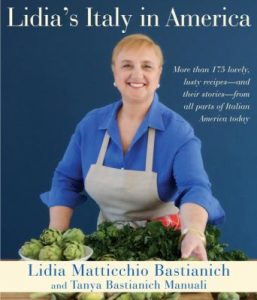 Though the group doesn’t always feature a cookbook, since Lidia has so many, we paired a recent title – Lidia’s Italy in America with the memoir. It is a companion to one of her PBS shows that showcases Italian-American specialties from across the US. In addition to recipes, there’s lots of history about Italian communities in America, both past and present. As in the memoir, the author’s tone is inquisitive, engaging, and affectionate; and most of us enjoyed these small history lessons. Some of us, though, don’t peruse a cookbook for the headnotes: give us the food! Unfortunately, results from the kitchen were decidedly mixed!
Though the group doesn’t always feature a cookbook, since Lidia has so many, we paired a recent title – Lidia’s Italy in America with the memoir. It is a companion to one of her PBS shows that showcases Italian-American specialties from across the US. In addition to recipes, there’s lots of history about Italian communities in America, both past and present. As in the memoir, the author’s tone is inquisitive, engaging, and affectionate; and most of us enjoyed these small history lessons. Some of us, though, don’t peruse a cookbook for the headnotes: give us the food! Unfortunately, results from the kitchen were decidedly mixed!
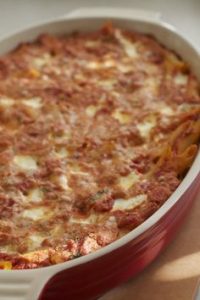 Some common threads emerged as we discussed recipes we made: for instance, many of the recipes made larger quantities than we might have wanted. Baked ziti (a classic if ever there was one) called for a full pound of pasta, a pound of ricotta, and a pound of mozzarella! The result was “good– but not great.” Pasta e fagioli and minestrone similarly resulted in an abundance of soup– almost 6 quarts! And neither recipe came up to snuff in the taste department, though this may partly be because dried cannellini beans proved difficult to find, and canned were substituted, which made for a less-flavorful broth. The minestrone recipe features a pestata, which appeared in several recipes; this is a fine-textured paste (hence the word) that is used as a flavor base. The pestata is made in a food processor, so if you don’t have one you’re kind of out of luck. What would nonna have done? It would have been helpful to provide an alternative method of creating the desired flavors in the dish.
Some common threads emerged as we discussed recipes we made: for instance, many of the recipes made larger quantities than we might have wanted. Baked ziti (a classic if ever there was one) called for a full pound of pasta, a pound of ricotta, and a pound of mozzarella! The result was “good– but not great.” Pasta e fagioli and minestrone similarly resulted in an abundance of soup– almost 6 quarts! And neither recipe came up to snuff in the taste department, though this may partly be because dried cannellini beans proved difficult to find, and canned were substituted, which made for a less-flavorful broth. The minestrone recipe features a pestata, which appeared in several recipes; this is a fine-textured paste (hence the word) that is used as a flavor base. The pestata is made in a food processor, so if you don’t have one you’re kind of out of luck. What would nonna have done? It would have been helpful to provide an alternative method of creating the desired flavors in the dish.
Another soup, escarole and white bean soup, 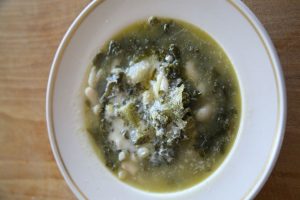 initially sounded appetizing, but “you would be mistaken!” The soup had way too much liquid and tasted like “dishwater– not even remotely good.” There was an overabundance of bitter greens (kale and escarole), and a lack of flavor despite 10 cloves of garlic. Not a keeper!
initially sounded appetizing, but “you would be mistaken!” The soup had way too much liquid and tasted like “dishwater– not even remotely good.” There was an overabundance of bitter greens (kale and escarole), and a lack of flavor despite 10 cloves of garlic. Not a keeper!
Surprisingly for an Italian book, we didn’t make that many pasta dishes. One restaurant favorite, penne rigate in vodka sauce, didn’t turn out quite right– the sauce was too loose, and when it was finally reduced, the taste was just OK. Rigatoni woodsman-style created some havoc in the kitchen, with crushed tomatoes escaping the pan, stress over the sauce not reducing properly, and a sudden recollection that someone didn’t like the main flavor in the sauce (sage). Whew! No wonder “I wouldn’t make it again!”
Similarly, 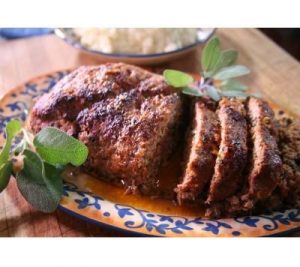 Italian American meatloaf did not endear itself to the cook, who struggled with 3 pounds of meat, bread cubes that didn’t seem to soften properly in milk (as instructed), and a finished loaf that sat in a pool of grease, as no rack was called for. But, “the flavor was good,” though not tempting enough to make again. Meatballs (from spaghetti and meatballs) were a much more successful use of ground meat; these also featured a pestata, but our cook had a food processor, and she liked the idea of adding the carrot, celery, and onion that way. The result was deemed “very good!”
Italian American meatloaf did not endear itself to the cook, who struggled with 3 pounds of meat, bread cubes that didn’t seem to soften properly in milk (as instructed), and a finished loaf that sat in a pool of grease, as no rack was called for. But, “the flavor was good,” though not tempting enough to make again. Meatballs (from spaghetti and meatballs) were a much more successful use of ground meat; these also featured a pestata, but our cook had a food processor, and she liked the idea of adding the carrot, celery, and onion that way. The result was deemed “very good!”
Another classic, chicken parmigiana, called for stuffing the chicken breasts with ricotta, which made a somewhat lengthy recipe even longer. It turned out “OK– but it needed something more.” Gloucester baked halibut had a topping of saltines and cheddar cheese, but the cheese flavor didn’t come through in the finished dish; and most in the group agreed that Ritz crackers are the go-to for this type of recipe. And shrimp scampi, also a dish with a pestata, seemed more complicated than it needed to be, and had too much butter. “America’s Test Kitchen’s recipe is simpler and better.”
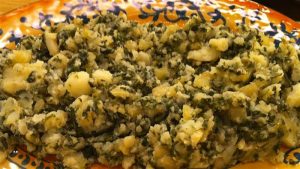 We tried some sides, too. Unfortunately, Swiss chard and potatoes was “a real disappointment.” It was “bland,” and the sliced almonds in the recipe didn’t seem to help matters. It made a lot, but a few days in the fridge didn’t improve the taste of the leftovers. Braised celery and mushrooms (from Lidia’s website) called for too much oil, but overall was tasty and did make good leftovers; “I’ll make this again.” Braised cauliflower with tomatoes was also a potential keeper, though “I would cut back on the tomato sauce next time.” Another cauliflower recipe, skillet cauliflower Torrisi, had a simple but delicious blend of olive oil, garlic, and Romano cheese topping the cauliflower– which unfortunately became mushy when cooked as instructed (braised, then roasted). But it was tasty enough to try again.
We tried some sides, too. Unfortunately, Swiss chard and potatoes was “a real disappointment.” It was “bland,” and the sliced almonds in the recipe didn’t seem to help matters. It made a lot, but a few days in the fridge didn’t improve the taste of the leftovers. Braised celery and mushrooms (from Lidia’s website) called for too much oil, but overall was tasty and did make good leftovers; “I’ll make this again.” Braised cauliflower with tomatoes was also a potential keeper, though “I would cut back on the tomato sauce next time.” Another cauliflower recipe, skillet cauliflower Torrisi, had a simple but delicious blend of olive oil, garlic, and Romano cheese topping the cauliflower– which unfortunately became mushy when cooked as instructed (braised, then roasted). But it was tasty enough to try again.
Broccoli with garlic and anchovies provided an opportunity to try anchovies (“I never cooked with them”); this recipe also featured an ingredient that mystified many of us: peperoncino flakes. We eventually realized this is just a fancy name for your basic red pepper flakes– which led to us wishing there had been a glossary, even a brief one, in the book. In the end, the broccoli was “just all right,” and the rest of the anchovies were enjoyed by the cat!  Braised fennel with sausage (there’s a lot of braising going on!) was excellent, especially if you’re a fennel freak like I am. You can eat it as a side or use it to dress pasta, or even as a pizza topping, perhaps for St. Louis pizza? This pizza has an unusual crust that contains baking powder; the crust is nicely thin but has a cracker-like texture. It was interesting, and quick to make, but couldn’t match the flavor of its yeast-based cousin.
Braised fennel with sausage (there’s a lot of braising going on!) was excellent, especially if you’re a fennel freak like I am. You can eat it as a side or use it to dress pasta, or even as a pizza topping, perhaps for St. Louis pizza? This pizza has an unusual crust that contains baking powder; the crust is nicely thin but has a cracker-like texture. It was interesting, and quick to make, but couldn’t match the flavor of its yeast-based cousin.
Oddly enough, we didn’t make many desserts! One person had future plans to make the luscious-looking Boston cream cake, which is a cupcake rendition of this well-known dessert. In addition to my fennel obsession, I love anything with figs, so I made St. Joseph’s fig cookies.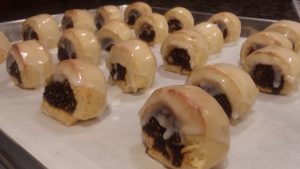 These had a delectable fig Newton-ish filling spiked with lemon, inside a rather tough, plain dough. They sure looked cute, but I think I’d prefer a more tender outside, even if it’s not traditional.
These had a delectable fig Newton-ish filling spiked with lemon, inside a rather tough, plain dough. They sure looked cute, but I think I’d prefer a more tender outside, even if it’s not traditional.
Overall, the cookbook was disappointing for most of us. Many of the recipes seemed somewhat time-worn, and we were often frustrated by inconsistent or unexpected results. We wondered if perhaps this book had been rushed to print so that it coincided with the TV show, without sufficient recipe testing for the home cook. Whatever the reason, this book didn’t call to most of us, but one person was so taken with it– the writing, the photography, the recipes– that she bought it. However she hasn’t used it yet because, at her house, “Mr. Fussy is on a diet!”
Voting on the cookbook reflected our “meh” feelings: we averaged out to a 2.8 (out of a possible 5). Lidia has lots of cookbooks to explore, but the feeling was, don’t waste your time on this one. We sure didn’t love this this book, but we really do ![]() Lidia!
Lidia!
Our next meeting will be on Friday, February 22 at 11 AM in the Fireplace Room. We’ll be discussing blogger Deb Perelman’s second book, Smitten Kitchen Every Day. Copies are available at the main desk. New members always welcome; see you there!
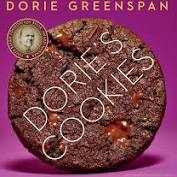
Bibliobites in November/December: Finding Dorie
 Who doesn’t love a cookie? They’re (mostly) neat to eat, they’re usually enjoyably petite, and they’re unintimidating to make. They’re a practical, popular, and yummy choice for parties and holiday dinners, and they’re eminently giftable. Prolific cookbook author and James Beard award-winner Dorie Greenspan’s Dorie’s Cookies tackles its eponymous topic with all the fervor and thoroughness you might expect from this baking maven. Did her collection of over 160 recipes hit the mark and help us attain cookie nirvana?
Who doesn’t love a cookie? They’re (mostly) neat to eat, they’re usually enjoyably petite, and they’re unintimidating to make. They’re a practical, popular, and yummy choice for parties and holiday dinners, and they’re eminently giftable. Prolific cookbook author and James Beard award-winner Dorie Greenspan’s Dorie’s Cookies tackles its eponymous topic with all the fervor and thoroughness you might expect from this baking maven. Did her collection of over 160 recipes hit the mark and help us attain cookie nirvana?
The size and heft of this book puts it squarely into coffee-table territory– literally, as it’s square rather than the more typical rectangle; so it easily stayed open– a quality much prized by group members! There are full-page photos of almost all the recipes; some people loved the closeup nature of the pictures (one cookie on a page– that’s a 9″ x 9″ cookie), but others thought the photos made the cookies look unnaturally shiny and plastic-y. The wider format of the pages made for a readable layout with ample white space; however, many of the headnotes were so long that a one-page recipe often overflowed into two or even three! Ingredients are listed by weight as well as volume, a plus for those of us who love our kitchen scales. Greenspan gives lots of ideas for changing up the recipes, and she lets you know which cookies freeze well, and the best way to do so; information much appreciated at a busy time of year. There were some complaints about baking times– for some of us, the indicated time almost always led to burned cookies, but others had the opposite experience! And knowing our own oven’s peculiarities didn’t always predict which issue we would have, so keep an eye on your cookies if it’s your first time with a particular recipe. But most importantly, how did the cookie crumble when it came time for baking and eating?
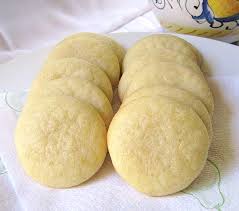 A couple of people tried the lemon sugar cookies, and both gave them high praise; though the dough was sticky and somewhat difficult to work with, the lemon flavor was strong and refreshing. The recipe has you rub sugar and lemon zest together with your fingers, which was effective in amping up that lemony tang. Almond crackle cookies were intriguing as they only have 3 ingredients (sugar, egg, and sliced almonds); they tasted good but fell apart and “went all over the place” when you tried to eat them. Perhaps these would be better crumbled over ice cream? Another recipe with a somewhat unusual list of ingredients was Natasha’s mum’s fruit and walnut bread bars. These had no fat in them at all; egg whites bind the fruit and nuts together. The result was a chewy, almost tough, bar that needed the recommended crystallized ginger to give it oomph; this recipe is an interesting idea but probably not a keeper. Also a bit different,
A couple of people tried the lemon sugar cookies, and both gave them high praise; though the dough was sticky and somewhat difficult to work with, the lemon flavor was strong and refreshing. The recipe has you rub sugar and lemon zest together with your fingers, which was effective in amping up that lemony tang. Almond crackle cookies were intriguing as they only have 3 ingredients (sugar, egg, and sliced almonds); they tasted good but fell apart and “went all over the place” when you tried to eat them. Perhaps these would be better crumbled over ice cream? Another recipe with a somewhat unusual list of ingredients was Natasha’s mum’s fruit and walnut bread bars. These had no fat in them at all; egg whites bind the fruit and nuts together. The result was a chewy, almost tough, bar that needed the recommended crystallized ginger to give it oomph; this recipe is an interesting idea but probably not a keeper. Also a bit different, 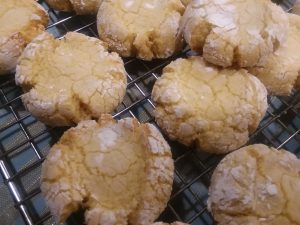 Moroccan semolina and almond cookies had a subtle citrus flavor and a slightly gritty texture from the semolina; a quality appealing to some, but a definite negative for others. Two bite one-chip cookies were a disappointment; they were “a pain to make” (you had to roll a small ball of dough, insert one chip into it, re-roll to hide the chip– 60 times!), and one person’s batch flattened out so much that the cookies looked a bit odd with their one little chocolate chip! Swedish dream cookies also flattened out too much and didn’t look much like their enticing photo, though the brown butter flavor was delicious. And crash-o cookies were a tasty version of oatmeal cookies (with raisins and chopped milk chocolate), but “they really needed nuts!”
Moroccan semolina and almond cookies had a subtle citrus flavor and a slightly gritty texture from the semolina; a quality appealing to some, but a definite negative for others. Two bite one-chip cookies were a disappointment; they were “a pain to make” (you had to roll a small ball of dough, insert one chip into it, re-roll to hide the chip– 60 times!), and one person’s batch flattened out so much that the cookies looked a bit odd with their one little chocolate chip! Swedish dream cookies also flattened out too much and didn’t look much like their enticing photo, though the brown butter flavor was delicious. And crash-o cookies were a tasty version of oatmeal cookies (with raisins and chopped milk chocolate), but “they really needed nuts!”
 Melody cookies are based on the classic Nabisco cookie of the same name; these had good chocolate flavor but the dough was sticky and hard to roll out, and “Deb Perelman’s (of Smitten Kitchen) version is better.” However, world peace cookies were satisfyingly chocolaty and buttery. They were the slice-and-bake type, which made them easy and convenient to produce. Coffee malteds were also a hit; though the dough was sticky (is there a theme here?) the flavor combination was excellent and worth the trouble. Hamantaschen were also a bit fussy to make, but the end result was “really good.” The fruit filling in particular drew high praise. Matzoh morsels were a dried fruit and chocolate no-bake treat which were a creative (if expensive) way to use up matzohs; they were deemed “okay– but I wouldn’t bother making them again.” Leckerli was a Swiss honey-almond cookie similar to lebkuchen; these were fragrant with honey and orange, and were simple to put together. They did call for candied orange peel, for which Greenspan gives a recipe. I was intrigued by the idea of making it myself; and it was so easy to do, and the results so superior to store-bought that I may never buy it again!
Melody cookies are based on the classic Nabisco cookie of the same name; these had good chocolate flavor but the dough was sticky and hard to roll out, and “Deb Perelman’s (of Smitten Kitchen) version is better.” However, world peace cookies were satisfyingly chocolaty and buttery. They were the slice-and-bake type, which made them easy and convenient to produce. Coffee malteds were also a hit; though the dough was sticky (is there a theme here?) the flavor combination was excellent and worth the trouble. Hamantaschen were also a bit fussy to make, but the end result was “really good.” The fruit filling in particular drew high praise. Matzoh morsels were a dried fruit and chocolate no-bake treat which were a creative (if expensive) way to use up matzohs; they were deemed “okay– but I wouldn’t bother making them again.” Leckerli was a Swiss honey-almond cookie similar to lebkuchen; these were fragrant with honey and orange, and were simple to put together. They did call for candied orange peel, for which Greenspan gives a recipe. I was intrigued by the idea of making it myself; and it was so easy to do, and the results so superior to store-bought that I may never buy it again!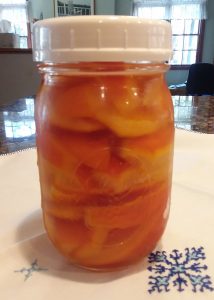
There’s a chapter towards the end of this book that’s called “cocktail cookies;” these are savory, (mostly) buttery bites that turned out to be the biggest hits in the book. Parmesan galettes were easy to make, and “I took them to a party and everyone loved them!” Continuing the cheesy/buttery theme, cheddar-seed wafers were enticingly cheesy and crispy, and they kept well. Rosemary-parm cookies had a somewhat off-putting color (from the pulverized fresh rosemary) but they tasted great, while sesame-sea salt cookies had a subtle yet addictive flavor that we enjoyed at our meeting! Goat cheese and chive cookies were a bit on the bland side; they’d benefit from a topper like the smoked salmon and cream cheese we also sampled at our meeting. And puffed grain and miso cookies were a fantastic, umami-laden version of rice cakes: sweet, salty, and craveable.
Overall, we enjoyed exploring this book: trying new versions of old favorites; branching out into different categories; or finding a new “keeper.” However, despite these positives, no one was rushing out to buy this book. Most of us already have plenty of cookie recipes that we love, not to mention cookie cookbooks; so we probably don’t need another tome for our already overstuffed shelves! And of course, many of the recipes in this (or any other) book are readily available online. If you’re new-ish to cookie-baking and want a book that pretty much covers it all, then this title could be really useful– to bake from and as a helpful reference. But for our group, the ratings once again told the tale: we averaged out to a 3.3 (out of a possible 5) rating. For us this book was likeable, just not a revelation– except for the cocktail cookies. Give ’em a try!
 Our next meeting will be Friday January 25 at 11 AM in the Fireplace Room. This month, it’s a twofer: we’ll be reading Lidia Bastianich’s memoir My American dream: a life of love, family, and food; and cooking from Lidia’s Italy in America. Copies of both are available at the main desk. New members always welcome!
Our next meeting will be Friday January 25 at 11 AM in the Fireplace Room. This month, it’s a twofer: we’ll be reading Lidia Bastianich’s memoir My American dream: a life of love, family, and food; and cooking from Lidia’s Italy in America. Copies of both are available at the main desk. New members always welcome!
Happy New Year to all!
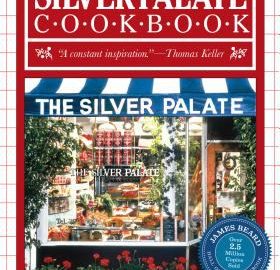
Bibliobites in October: Time Travelers
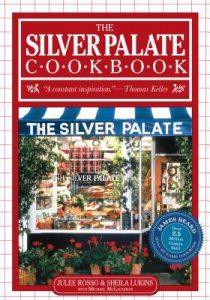 It’s not just a flux capacitor that makes time travel possible– books also have the uncanny ability to take us to another time and place. This month’s title, The Silver Palate Cookbook, brought us back to the 1980s: that Reaganesque decade of big hair, big shoulder pads, and big business. In the 80s, two nascent food trends converged to bring about an unprecedented expansion of food choices, both in restaurants and at the supermarket: the California-casual farm-to-table movement spearheaded by Alice Waters at Chez Panisse; and the New York upscale (dare I say yuppie?) style of new-wave French chefs like Daniel Boulud at Le Cirque. Both trends have produced long-lasting changes in the way we think about, produce, and prepare our food. For us East-coasters, both Martha Stewart and the Silver Palate team of Julee Rosso and Sheila Lukins brought these trends to the home cook. But that was more than 30 years ago– have their innovations stood the test of time?
It’s not just a flux capacitor that makes time travel possible– books also have the uncanny ability to take us to another time and place. This month’s title, The Silver Palate Cookbook, brought us back to the 1980s: that Reaganesque decade of big hair, big shoulder pads, and big business. In the 80s, two nascent food trends converged to bring about an unprecedented expansion of food choices, both in restaurants and at the supermarket: the California-casual farm-to-table movement spearheaded by Alice Waters at Chez Panisse; and the New York upscale (dare I say yuppie?) style of new-wave French chefs like Daniel Boulud at Le Cirque. Both trends have produced long-lasting changes in the way we think about, produce, and prepare our food. For us East-coasters, both Martha Stewart and the Silver Palate team of Julee Rosso and Sheila Lukins brought these trends to the home cook. But that was more than 30 years ago– have their innovations stood the test of time?
It was obvious to all of us that this was an older cookbook– it has no full-color photos; in fact it has no photos of any kind! The illustrations are all pen-and-ink drawings, which some people enjoyed; but others missed the lush photography found in newer books. The overall layout of the book was easy on the eyes, and we enjoyed the authors’ amusing and/or informative sidebars found throughout. From a 2018 perspective, it was fun to read descriptions of, and recipes for, ingredients that were a novelty then, but are now found in any large supermarket (pesto, anyone?). Some in the group had well-loved copies of this title, and had fond memories of particular recipes they frequently made. Many had received this book as a gift, or had gifted copies to family and friends. And as you might expect from a cookbook based on the products of a gourmet shop, many of the recipes were for “fancy” or party food. Some recipes were three pages long and took three days to prepare! We didn’t tackle any of those.
We did our best, however, to enter into the spirit of the decade. Braised short ribs had a nice sauce; the ingredients married well and made for a tasty dinner. Our intrepid cook commented, “I followed everything to a T– except for a few things,” so your results may differ somewhat! Winter pork and fruit ragout also really hit the spot– the various fruits were a surprisingly delicious addition to this warming stew. And osso buco was an excellent version of this classic; it’s time-consuming but worth the trouble. On the other hand, beef stew with cuminseed was “one of the worst beef stews ever.” It had way too much cumin; its flavor overpowered everything else. This recipe was also downgraded because you had to pit 1 1/2 cups of olives! There were lots of chicken recipes in this book; lemon chicken was “pretty good” and was also good left over, but it didn’t have a crisp golden crust as promised. 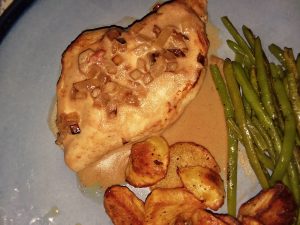 Raspberry chicken wasn’t a winner– the recipe instructed you to cook onions for so long that it was easy to burn them; and though the dish was pleasantly fruity, the raspberry flavor didn’t really come through. And chicken monterey was “tasteless– a lot of work for not much.”
Raspberry chicken wasn’t a winner– the recipe instructed you to cook onions for so long that it was easy to burn them; and though the dish was pleasantly fruity, the raspberry flavor didn’t really come through. And chicken monterey was “tasteless– a lot of work for not much.”
We made a few soups, too– white bean and sausage soup had a fairly ho-hum list of ingredients, but in this case the whole was much more delicious than the parts might have indicated. A keeper! Curried butternut squash soup was likewise delectable; it was velvety and rich-tasting without being heavy. And one person praised roasted yellow pepper soup (from the Silver Palate New Basics book)– that’s a keeper, too. With your soup, you might enjoy Grandma Clark’s soda bread, which had outstanding texture and taste. Or how about zucchini bread, a tasty vehicle for excess garden production. This version is “moist and stays fresh” and was praised for its spicing and walnuts. Despite the fact that this loaf, like all zucchini breads, has no discernible squash taste, “Mr. Fussy won’t touch it!”
A couple of people tried pasta dishes; Mr. Fussy inexplicably enjoyed the pasta puttanesca, which contains anchovies, an ingredient on many people’s “will not eat” list. Perhaps the spicy tomato-based sauce makes up for a lot? Another pasta classic, spaghetti with oil and garlic, somehow wasn’t flavorful– despite a healthy dose of garlic, the dish was “ordinary.” 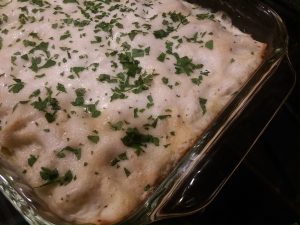 Green lasagna was a bit of work, as all lasagnas are; but it was enjoyably light and fresh despite plenty of cheese and a bechamel sauce. Vegetable purees must have been something novel and exciting in the 80s; this book has a (short) chapter devoted to them. One person made beet and apple puree, which turned out to be a tasty, fruity combination that wasn’t too beet-y, a plus for those of us who have a love/hate relationship with beets.
Green lasagna was a bit of work, as all lasagnas are; but it was enjoyably light and fresh despite plenty of cheese and a bechamel sauce. Vegetable purees must have been something novel and exciting in the 80s; this book has a (short) chapter devoted to them. One person made beet and apple puree, which turned out to be a tasty, fruity combination that wasn’t too beet-y, a plus for those of us who have a love/hate relationship with beets.
Moving on to dessert, orange cake had plenty of its namesake flavor and a pleasant, not too dense texture, but “my own recipe is still better.” Toffee bars featured a shortbread crust topped with melted chocolate and chopped nuts; these were good but weren’t very toffee-ish (needed molasses or dark brown sugar?), and the batter was quite stiff and difficult to spread in the pan. One baker in the group who has a long history with this title recommended the oatmeal raisin cookies and shortbread hearts (“great as a base for bars, or to dip in chocolate”). At our meeting we sampled raspberry muffins from The Silver Palate Good Times Book; these were tart and tasty with fresh raspberries and a streusel topping.
Despite our many successes, most people felt that the book was somewhat dated. Food styles do change, and what was new and exciting to eat thirty years ago doesn’t necessarily entice us now. The party/fancy food focus of the book was a bit off-putting for some, and there were complaints that some recipes were scaled for a caterer rather than a home cook, and/or were overly meat-centric. So while it may be fun to wander down memory lane, most of us are content to leave this book on the history shelf! These opinions were, as ever, reflected in our voting: we averaged out to a 2.6 (out of a possible 5). More than half the group rated it a 2!
 Our next meeting will be a combined November/December meeting on Friday, December 7 at 11 AM in the Fireplace Room. This month we’re baking our way through Dorie Greenspan’s Dorie’s Cookies. Copies are available at the main desk; all are welcome to join us. Hope to see you there!
Our next meeting will be a combined November/December meeting on Friday, December 7 at 11 AM in the Fireplace Room. This month we’re baking our way through Dorie Greenspan’s Dorie’s Cookies. Copies are available at the main desk; all are welcome to join us. Hope to see you there!

CPL 2018 Apple Pie Contest: Fourteen Pies are Way Better Than One
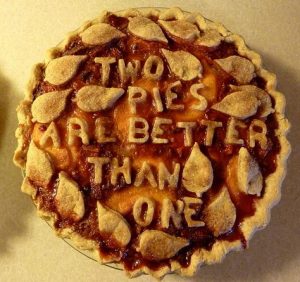 Could there be a better way to spend a late fall Sunday afternoon than tasting your way through 14 lovely homemade apple pies? This year’s apple pie contest on Sunday, October 28 more than delivered on its fragrant promise of tart fruit filling and flaky crust.
Could there be a better way to spend a late fall Sunday afternoon than tasting your way through 14 lovely homemade apple pies? This year’s apple pie contest on Sunday, October 28 more than delivered on its fragrant promise of tart fruit filling and flaky crust.
As one of four judges, I had the taxing job of deciding which pies were the best. While it’s true that pie tasting isn’t a really tough task, in practice it turned out to be more difficult than you might think. Apple pie is a pretty simple dish with few ingredients, so it was fascinating that each pie had a unique taste and texture; and parsing everyone’s pie components– and comparing them to several others– was a bit tricky. Personal preference also played a part: do you like your pie apples thinly sliced or chunky? And which varieties of apples? Should the liquid in the pie be runny or thickened? Which spices are best, and how much? What about other additions, like lemon juice? Crust made with shortening, lard, butter, or any combination thereof? Multiply all these factors by fourteen pies and four tasters and you have a recipe for complexity! Nonetheless we bravely persevered and were, perhaps surprisingly, united in our eventual rankings.
 In general, the judges preferred a pie filling with assertive apple flavor and a bit of spice. Though variety may be the spice of life, in an apple pie the traditional duo of cinnamon and nutmeg always seemed to work the best. Lemon juice is a traditional flavor brightener for pies; we appreciated this as long as its presence didn’t dominate. Though we didn’t want a runny pie, we also downgraded pies with too much thickener, or those whose thickener had a detectable taste. Almost all the pies had excellent apple flavor, which you might expect in an area that grows a bounty of apple varieties. However some fillings had apparently been overbaked (or the apples weren’t good bakers) and were mushy; we preferred a pie where the apples were definitely cooked but still had some chew to them.
In general, the judges preferred a pie filling with assertive apple flavor and a bit of spice. Though variety may be the spice of life, in an apple pie the traditional duo of cinnamon and nutmeg always seemed to work the best. Lemon juice is a traditional flavor brightener for pies; we appreciated this as long as its presence didn’t dominate. Though we didn’t want a runny pie, we also downgraded pies with too much thickener, or those whose thickener had a detectable taste. Almost all the pies had excellent apple flavor, which you might expect in an area that grows a bounty of apple varieties. However some fillings had apparently been overbaked (or the apples weren’t good bakers) and were mushy; we preferred a pie where the apples were definitely cooked but still had some chew to them.
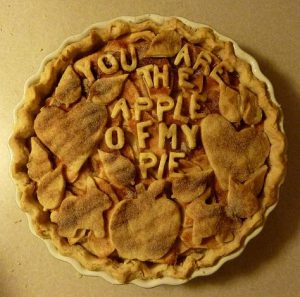 Moving on to the anxiety-inducing crust, we looked for tenderness, flakiness, and a complementary flavor to the apples. We downgraded crusts that had a pasty quality, were under- or over-salted, or were too thick. One of the holy grails of pie baking is a crisp, well-cooked bottom crust, but alas– none of the pies really achieved this admittedly difficult feat. We did admire many beautiful, golden top crusts; and some pies gilded the lily with coarse sugar sprinkles and/or pastry cutouts. Beyond good looks, the tastiest crusts tended to be those that were at least partially made with butter. It’s hard to beat butter’s distinct and delicious flavor!
Moving on to the anxiety-inducing crust, we looked for tenderness, flakiness, and a complementary flavor to the apples. We downgraded crusts that had a pasty quality, were under- or over-salted, or were too thick. One of the holy grails of pie baking is a crisp, well-cooked bottom crust, but alas– none of the pies really achieved this admittedly difficult feat. We did admire many beautiful, golden top crusts; and some pies gilded the lily with coarse sugar sprinkles and/or pastry cutouts. Beyond good looks, the tastiest crusts tended to be those that were at least partially made with butter. It’s hard to beat butter’s distinct and delicious flavor!
After an hour of tasting, discussing, re-tasting, and a bit of give-and-take, we judges had our winners: first prize went to Tina Starner; second prize to Tony Blank; and third to Pat Enwright. Pat also had the distinction of winning the People’s Choice award! Thank you to all the contestants who took the time and effort to make a pie from scratch. Thanks to the Friends of the Library for sponsoring this enjoyable annual event. So start practicing! Next year’s contest will be here before you know it.
Love pie? Want to learn more about all aspects of creating this iconic American dessert? Check out these titles at the Chelmsford Public Library, and happy baking!





